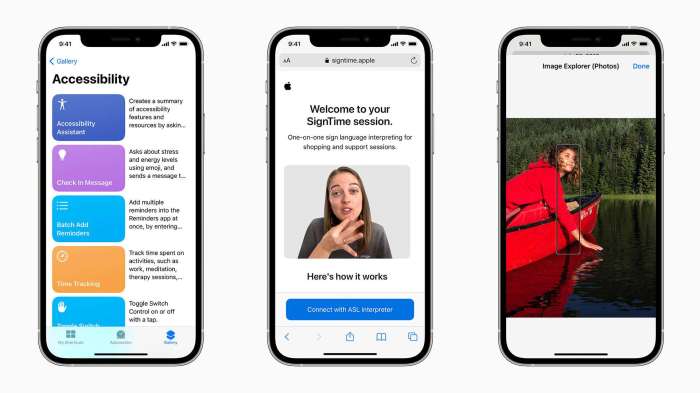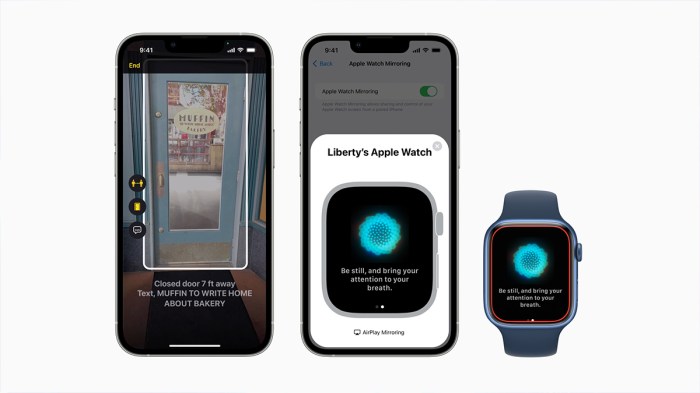Apple Accessibility Features 2024: Making Tech Inclusive, is a game-changer for people with disabilities. Apple’s commitment to accessibility isn’t just a buzzword – it’s a fundamental principle driving their design and development. This year, Apple is pushing the boundaries with new and enhanced features across iOS 17 and macOS 14, ensuring everyone can experience the magic of technology, regardless of their abilities.
From groundbreaking visual aids to innovative audio enhancements, Apple is empowering users with a range of features that cater to diverse needs. Whether it’s navigating your device with ease, staying connected through clear communication, or accessing information in a way that suits your unique learning style, Apple is making the digital world a more inclusive place.
Accessibility Features for Motor Skills
Apple’s commitment to accessibility extends to users with motor impairments, offering a range of features designed to empower them to fully engage with their devices. These features allow users to control their devices and interact with apps with ease, regardless of their physical limitations.
AssistiveTouch
AssistiveTouch provides a virtual home button on the screen, offering users with limited hand mobility an alternative way to navigate their devices. This feature allows users to perform actions like tapping, swiping, and long-pressing without physically touching the screen. For instance, a user with limited finger dexterity can use AssistiveTouch to activate Siri, open the Control Center, or even take a screenshot.
Switch Control
Switch Control allows users to control their devices using external switches or even just a single switch. Users can configure their devices to respond to a variety of inputs, such as head movements, eye blinks, or a single switch press. This feature enables users with severe motor impairments to access and control their devices with greater independence. For example, a user can configure Switch Control to navigate through menus, select apps, and type using a single switch.
Other Features
In addition to AssistiveTouch and Switch Control, Apple offers several other accessibility features designed for users with motor impairments. These features include:
- Voice Control: Allows users to control their devices using their voice, eliminating the need for physical interaction with the screen.
- Type to Speak: Converts text into speech, allowing users to communicate and interact with their devices without needing to type.
- AssistiveTouch Customization: Users can customize the AssistiveTouch menu to include frequently used actions and gestures, enhancing accessibility and personalization.
- Switch Control Customization: Users can personalize Switch Control settings, allowing them to configure the feature to meet their individual needs and preferences.
Accessibility Features for Cognitive Differences: Apple Accessibility Features 2024
Cognitive differences encompass a wide range of challenges that can affect an individual’s ability to process information, learn, and interact with the world around them. Apple has implemented a variety of accessibility features specifically designed to support users with cognitive differences, aiming to create a more inclusive and user-friendly experience.
Voice Control
Voice Control enables users to interact with their Apple devices using their voice, eliminating the need for physical interaction. This feature is particularly beneficial for individuals with motor impairments, but it also provides significant advantages for users with cognitive differences. By using voice commands, users can navigate menus, open apps, write emails, and perform various tasks without relying on complex visual or physical interfaces. This can be particularly helpful for individuals with cognitive challenges such as dyslexia or ADHD, who may find traditional interfaces overwhelming or difficult to navigate.
Guided Access, Apple accessibility features 2024
Guided Access allows users to limit the functionality of their device to a specific app or set of features, effectively simplifying the user interface and reducing distractions. This feature can be invaluable for individuals with cognitive differences who might benefit from a more focused and controlled environment. For example, a user with attention deficit disorder (ADD) might find it challenging to stay on task while using an app with multiple features and notifications. Guided Access allows them to disable distracting elements, such as notifications and other apps, creating a more streamlined and focused experience.
Other Tools
Apple also offers several other tools that can enhance cognitive accessibility. These include:
- AssistiveTouch: This feature provides an on-screen menu that allows users to control their device using gestures, eliminating the need for physical buttons. This can be particularly helpful for individuals with motor impairments or cognitive differences that make it challenging to interact with physical buttons.
- Live Text: This feature allows users to select and interact with text in images and videos. This can be beneficial for individuals with cognitive differences who may find it difficult to read traditional text formats.
- Zoom: This feature allows users to magnify the screen, making it easier to see text and images. This can be helpful for individuals with visual impairments or cognitive differences that affect their ability to process visual information.
Apple’s Approach to Accessibility Testing and User Feedback
Apple is deeply committed to making its products and services accessible to everyone. A crucial aspect of this commitment is the company’s rigorous testing and user feedback process, which plays a vital role in shaping its accessibility roadmap.
Apple’s Accessibility Testing Process
Apple employs a multi-faceted approach to ensure its accessibility features are effective and meet the needs of diverse users. This includes:
- Internal Testing: Apple’s own engineers and designers, many of whom have personal experience with accessibility needs, conduct extensive internal testing of features. This ensures that features are thoroughly evaluated for usability, functionality, and compliance with accessibility standards.
- External Testing: Apple collaborates with external accessibility experts, organizations, and individuals with disabilities to gather feedback and insights. This helps identify potential issues and ensure that features are truly inclusive and meet real-world needs.
- User Studies: Apple conducts user studies with individuals who use accessibility features. This involves observing users interacting with products and services, gathering feedback on their experiences, and identifying areas for improvement.
- Accessibility Guidelines and Standards: Apple adheres to industry-recognized accessibility guidelines and standards, such as the Web Content Accessibility Guidelines (WCAG) and the Americans with Disabilities Act (ADA). This ensures that its products and services meet the highest standards of accessibility.
How Apple Gathers User Feedback
Apple actively seeks user feedback to inform its accessibility efforts. This feedback is crucial for identifying areas for improvement and ensuring that features meet the needs of the widest possible range of users.
- Apple Feedback Assistant: Users can submit feedback directly through the Apple Feedback Assistant, a dedicated app for reporting accessibility issues and suggesting improvements.
- Apple Support Communities: Apple’s online support communities provide a platform for users to share their experiences, discuss accessibility features, and provide feedback to Apple.
- Accessibility Events and Workshops: Apple regularly hosts accessibility events and workshops, providing opportunities for users to share their experiences and provide input on future features.
- Direct Outreach: Apple actively reaches out to accessibility experts, organizations, and individuals with disabilities to gather feedback and insights.
The Role of User Feedback in Shaping Apple’s Accessibility Roadmap
User feedback is instrumental in shaping Apple’s accessibility roadmap. It informs the development of new features, the improvement of existing features, and the overall direction of Apple’s accessibility efforts.
“User feedback is essential for us to understand the needs of our users and to make sure that our products and services are truly accessible to everyone.” – Apple Accessibility Team
- Prioritizing Features: User feedback helps Apple prioritize the development of accessibility features that are most needed by users. For example, feedback on VoiceOver led to the development of features such as VoiceOver Rotor and VoiceOver Gestures.
- Improving Existing Features: User feedback helps Apple identify areas for improvement in existing accessibility features. This feedback can lead to enhancements in usability, functionality, and overall user experience.
- Developing New Features: User feedback is a key source of inspiration for new accessibility features. Apple uses feedback to understand the unmet needs of users and to develop new features that address those needs.
Future Directions for Apple Accessibility
Apple’s commitment to accessibility has been a cornerstone of its product philosophy for years. As technology continues to evolve, Apple is constantly innovating to create a more inclusive experience for all users. Looking ahead, several exciting possibilities emerge for Apple’s accessibility journey.
Emerging Technologies and Accessibility
The integration of emerging technologies presents a unique opportunity to revolutionize accessibility. Artificial intelligence (AI) and machine learning (ML) hold immense potential in this domain. Imagine a world where AI-powered assistive technologies can anticipate user needs and provide personalized support, proactively addressing challenges before they arise.
- AI-powered personal assistants can learn user preferences and habits, automatically adjusting settings and providing tailored recommendations for accessibility features.
- Machine learning algorithms can analyze user interactions and predict potential accessibility barriers, enabling proactive intervention and a smoother user experience.
Beyond AI, advancements in augmented and virtual reality (AR/VR) can create immersive and interactive experiences that cater to diverse needs. Imagine visually impaired users navigating a virtual environment with enhanced spatial awareness or individuals with mobility limitations experiencing a virtual world free from physical constraints.
Apple’s commitment to accessibility in 2024 is a testament to their belief that technology should be accessible to all. With a focus on user feedback and continuous improvement, Apple is shaping a future where everyone can participate and thrive in the digital world. This isn’t just about features; it’s about creating a truly inclusive experience that empowers everyone to unlock their potential.
Apple’s accessibility features for 2024 are expected to be game-changing, especially for those who want to stay on top of events like the FIFA Women’s World Cup. To make sure you don’t miss a single goal, you can easily add the FIFA Women’s World Cup Google Calendar to your device, and Apple’s accessibility features will ensure you get timely notifications and reminders.
This way, you can cheer on your favorite team without missing a beat, even if you have visual or auditory impairments.
 Standi Techno News
Standi Techno News

